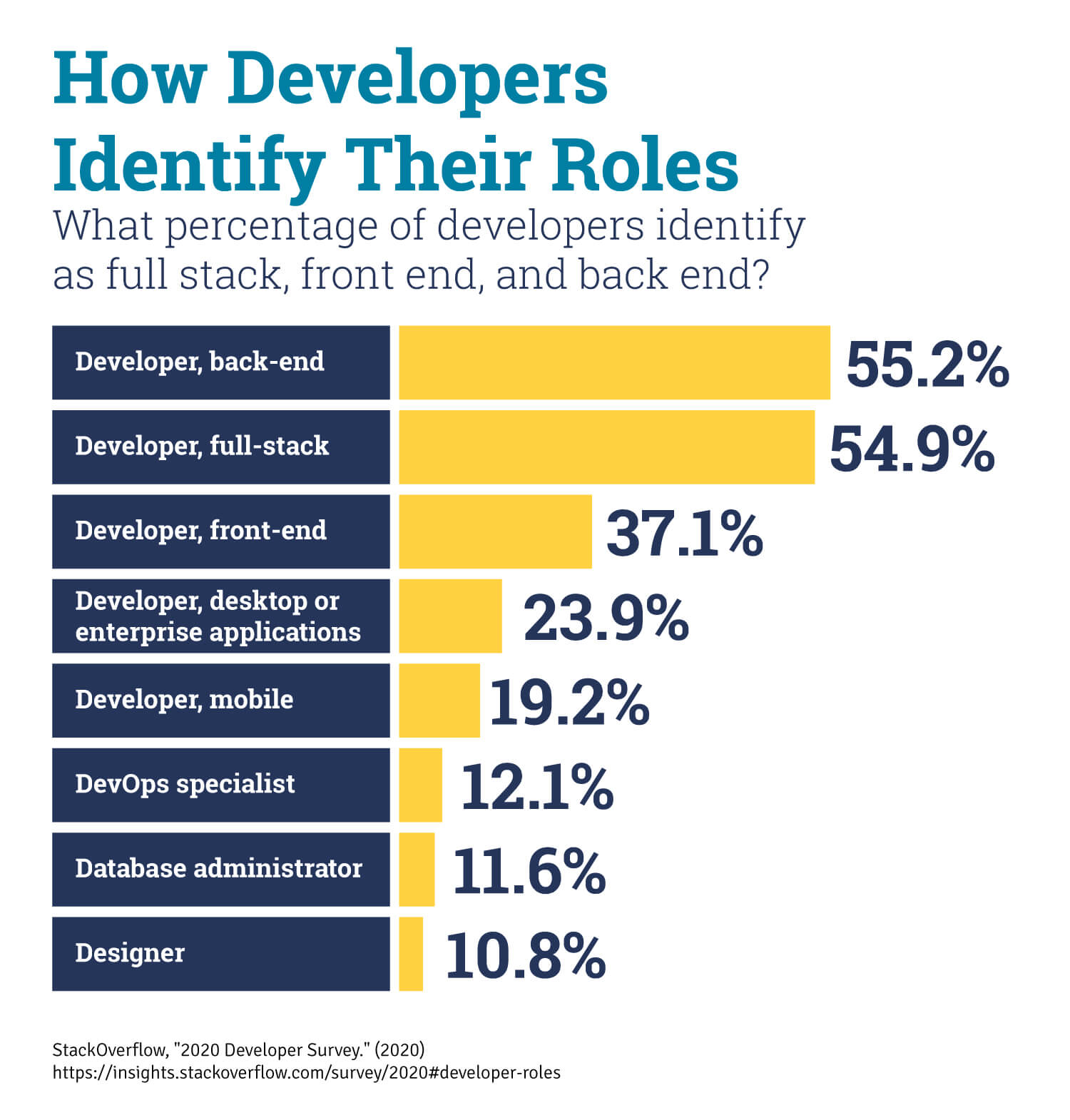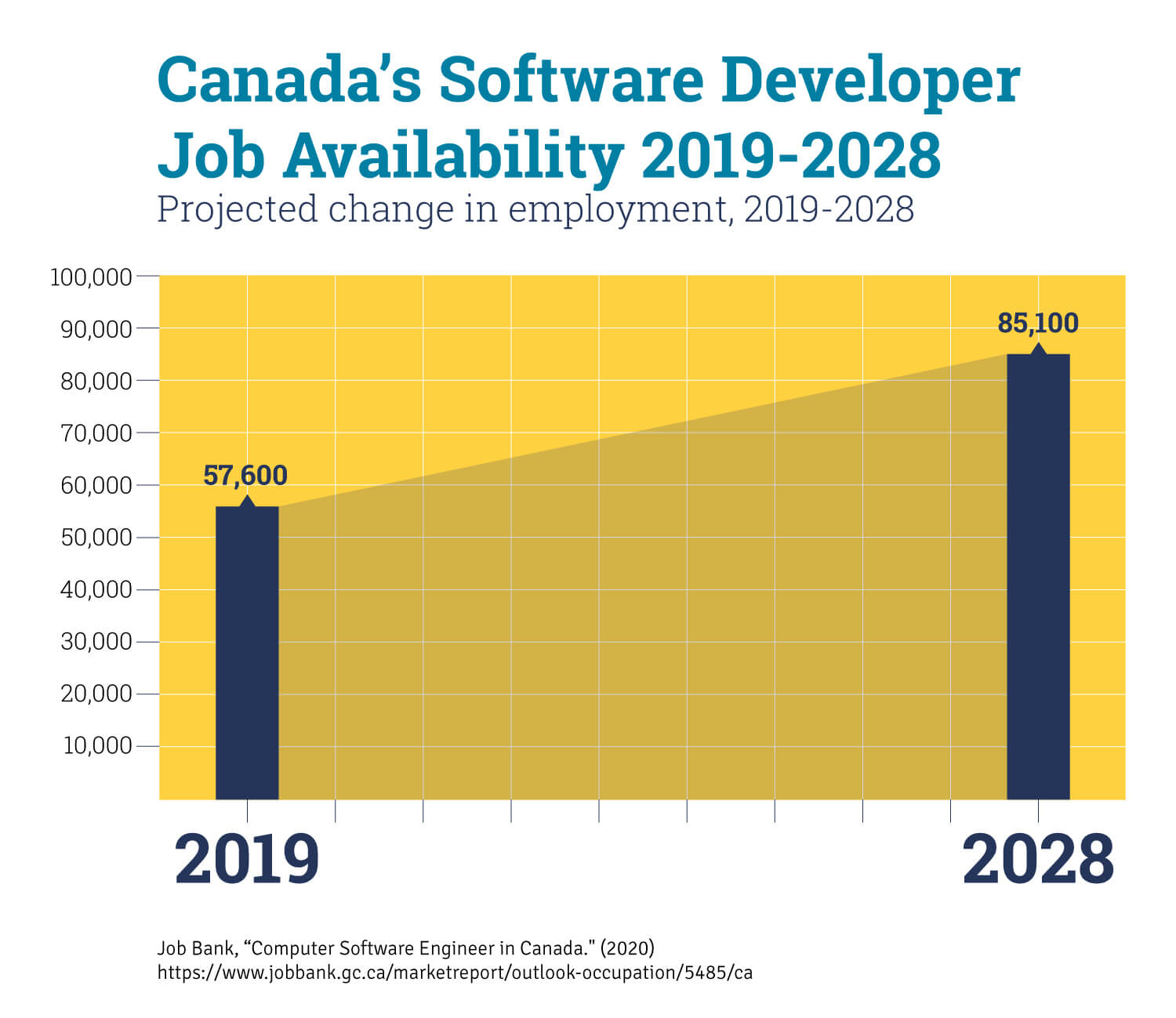What Is a Full Stack Developer & What Do They Do?

You’ve probably heard the term full stack developer tossed around by in-the-know coworkers or on tech forums, especially if you’ve started considering a career in coding. But what is a full stack developer, and what do they do?
Put simply, full stack developers are the Swiss army knives of the development world. As masters of multiple programming languages, these savvy professionals are capable of transitioning seamlessly from one development environment to the next. A boundless sense of curiosity drives full stack developers — it’s not enough to know that something works, they need to understand the how and why behind each functionality.
Does this sound like you? If so, keep reading. This article will provide a comprehensive overview of precisely what full stack developers are, what they do, and where they fit within the development sector.
What is a Full Stack Engineer?
Full stack technology refers to the entire depth of a computer system application, and full stack developers straddle two separate web development domains: the front end and the back end.
The front end includes everything that a client, or site viewer, can see and interact with. By contrast, the back end refers to all the servers, databases, and other internal architecture that drives the application; usually, the end-user never interacts with this realm directly.
The easiest way to put the full stack into perspective is to imagine a restaurant. The front end encompasses the well-decorated, comfortable seating areas where visitors enjoy their food. The kitchen and pantry make up the “back end” and are typically hidden away from the customer’s view. Chefs (developers) gather permanently stored materials from the pantry (the database) and perform operations on it in the kitchen (the server), and then serve up fully-prepared meals (information) to the user.
Front end developers work to optimize the visible parts of an application for web browsers and mobile devices. Front end platforms are usually built with HTML, CSS, and JavaScript; however, they can also be made via pre-packaged code libraries or content management systems like WordPress. Back end developers, in contrast, refine the software code that communicates with servers, databases, or other proprietary software that conveys information to front end interfaces.
Those knowledgeable in both front end and back end are called full stack developers, meaning they are well versed in both disciplines.
The term “full stack developer” originated during the early days of the web, when websites were small and uncomplicated enough to allow a single person to tackle every aspect of site-building. But in the decades since those initial days, the web has grown ever more complex. The rise of machine learning, predictive computing, and responsive design has made it challenging — but not impossible! — for a single developer to handle every aspect of building and designing a site or application.
Today, modern businesses often rely on entire teams of developers to operate network equipment, work with virtual machines, and manage enormous databases. It takes time to develop a comprehensive, nuts-and-bolts understanding of all these emerging technologies. The developers who do so are, for that reason, versatile enough to shift fluidly between front and back end development and take on any task that their team might need them to tackle.
According to a 2020 Stack Overflow survey of 65,000 developers worldwide, roughly 54.9 percent, identify as full stack.
(For contrast, 55.2 percent of those surveyed identified themselves as back end developers, 37.1 percent self-identified as front end developers, and just 19.2 percent claimed to be mobile developers.)

The modern full stack developer is an experienced generalist who can build a minimal viable product — i.e., an application with enough functionality to please early customers and spark feedback for continued development — on their own. Companies rely on full stack professionals to spot errors between the front and back end and tackle tasks that straddle both disciplines. This versatility has become increasingly vital as newer apps begin to incorporate AI and other sophisticated technologies into their programming.
These days, it’s mission-critical to have at least one person on a given development team who has a passing understanding of all the components that run an enterprise-level application. And companies understand this need. According to statistics provided by the Government of Canada’s Job Bank, new job openings for software developers are expected to top 27,500 between 2019 – 2028; however, current analyses project that only 24,000 new job seekers will be available to fill them. This shortfall will undoubtedly drive demand, spark battles for talent, and give new professionals a greater advantage in their job search.

But all of this begs the question — what responsibilities does a full stack professional face?
Let’s address.
What Does a Full Stack Developer Do?
Full stack developers take on a broad set of responsibilities. They must be fluent in creating websites with a robust internal architecture and delivering an interactive and intuitive interface to clients. A full stack developer must be well-versed in HTML, CSS, and JavaScript and know their way around back end technologies and database structures.
These professionals usually work with a product through its initial creation until its final launch, using industry-standard practices to ensure that technical concerns are adequately addressed at every development stack level.
Full stack developers start by brainstorming platforms alongside a graphic design team, often reviewing prototypes before turning them into coded products. Then, these multi-talented programmers craft functional databases and servers to support client-facing content, always evaluating how responsive an app is for end-users and troubleshooting problems as necessary.
The best full stack developers also keep abreast of current industry trends and emerging technologies and understand how to deploy upcoming technologies to suit their employers’ needs.
Everyday responsibilities of the profession include:
- Working with CSS, HTML, and JavaScript, along with CSS preprocessors, to craft client-facing platforms
- Managing databases and servers
- Coding for functionality across multiple languages and platforms
- Communicating with specialized developers and the graphic design team to deliver the best possible product
- Keeping up with emerging technology that may serve the business’ needs
- Prototyping minimal viable products for communication with company stakeholders
Are Full Stack Developers in Demand?
In short, yes!
“Full stack engineer” currently ranks #8 on Linkedin’s list of emerging jobs for the Canadian job market. It should be of little surprise why full stack developers are so in demand; these professionals are valued for their breadth of experience across technology platforms. Full stack developers occupy the best position to interact with back end, front end, and design teams.
More than that, full stack developers can thrive in industries far and wide beyond tech. The same report further found that the top sectors for full stack developers included computer software, information technology and services, internet, financial services, and marketing and advertising.
Virtually all modern companies rely on business logic and client-facing platforms to advertise their services, convert new clients, and automate day-to-day operations.
What Does a Full Stack Developer Need to Know?
While the demands of a full stack developer’s role will depend on their specific industry and job, all will need to have the same core set of front and back end development skills.
Front End Development
Front end, or client-side, development is the practice of producing an interface that end users can view. A front end developer’s primary goal is to develop a visually pleasing and easy-to-use platform.
Front end development has become more complicated as users interact with sites through different devices, such as smartphones, tablets, and desktops. Today, developers need to ensure a site renders correctly across different browsers, operating systems, and device types.
The requirements for front end development are always evolving as new technologies are introduced; however, there are a few front end skills that all full stack developers should master.
This universal front end skill set includes:
Back End Development
Back end development refers to the work that goes on behind the scenes of a site or application — the underlying architecture of the product. The term encompasses the database, server, and other intermediary proprietary software.
Developers must know how to organize the logic of a system so that the overarching program or website can run properly. All frameworks and libraries must be integrated into the application and organized in a way that allows other developers to maintain that codebase over time.
To accomplish this goal, back end developers must have a robust set of foundational skills. This should include:
How to Learn the Skills
Thankfully, there are many different ways to pick up the expertise necessary to become a knowledgeable full stack developer. While some companies may favor those who attain a certain level of education, most are primarily concerned with whether or not you have the chops to succeed in a given role.
Most full stack developers have attained at least a bachelor’s degree in computer science, programming, or web development. If you have yet to achieve your degree, a college education can give you broad theoretical and practical knowledge and excellent industry contacts.
According to one recent Stack Overflow study, 49.3 percent of professional developers have a bachelor’s degree. The same study further found that 24.4 percent of developers viewed formal education as “very important,” 26.4 percent as “fairly important,” and 23.7 percent as “somewhat important.”
That said, developers who don’t have formal degrees but have impressive portfolios, solid references, and open source work can also be highly competitive candidates.
Though difficult, it’s possible to achieve all the necessary skills through self-directed training. If you’re disciplined and passionate enough, you can use low-cost online classes, books, and tutorials as a springboard to leap into a full stack development career.
If you prefer a more formalized learning experience but don’t have the time or resources to pursue a conventional four-year degree, you may want to consider a coding boot camp.
Coding boot camps are intensive courses that equip you with the practical industry knowledge and skill set you’ll need to land that first entry-level job. Most boot camps last between three to six months; during that time, you’ll develop portfolio-worthy projects and build relationships with industry professionals.
But don’t commit to an educational route without thinking through your needs and situation.
Before enrolling in your first course, ask yourself these key questions:
- How much time do I have to dedicate to learning?
- Do I need a part- or full-time schedule?
- Do I learn better in a virtual or in-person environment?
- What’s a doable price range for my education?
- How soon do I want to apply for full stack development jobs?
Any of the above learning routes can provide you with the experience you need to thrive professionally — but which works best for you? Only you can decide.
How Will You Make Your Mark In Full Stack Development?
Now more than ever before, full stack developers have risen to prominence in the development world as companies increasingly rely on their versatile mix of expertise and generalization. Aspiring programmers now face a tremendous opportunity to build rewarding careers in a growing industry.
So, what are you waiting for? Consider your educational opportunities and start pursuing a career in full stack development today.

 Live Chat
Live Chat